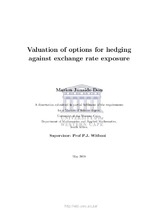| dc.contributor.advisor | Witbooi, Peter | |
| dc.contributor.author | Don, Marlon Junaide | |
| dc.date.accessioned | 2020-02-17T10:47:49Z | |
| dc.date.available | 2020-02-17T10:47:49Z | |
| dc.date.issued | 2019 | |
| dc.identifier.uri | http://hdl.handle.net/11394/7113 | |
| dc.description | >Magister Scientiae - MSc | en_US |
| dc.description.abstract | The risk associated with currency exposure is one of the main sources of risk in terms of internationally
diversi ed portfolios. Controlling the risk is important for improving the performance
of international investments. One approach to hedging against exchange rate exposure is by employing
financial derivatives, particularly, foreign currency options. Currency options provide
insurance against unfavorable exchange rate
fluctuation, but also make provision to lock in a
pro t when the exchange rate
fluctuation are favorable. However, these instruments cannot be
traded or managed without the relevant valuation techniques.
In this dissertation we discuss one of the approaches to cover the risk associated with currency
exposure. In particular, we focus on the partial differential equation (PDE) valuation of
currency options by employing various finite difference schemes. We commence by introducing
the mathematical tools required for the valuation of financial derivatives. Thereafter we study
the valuation of European options. This involves deriving the famous Black-Scholes PDE for
pricing options on stocks that do not yield dividends. Using the Black-Scholes PDE we derive
the Black-Scholes formula for pricing European options. This derivation involves transforming
the Black-Scholes PDE into the heat equation and by solving the heat equation we obtain the
Black-Scholes formula. After completing the pricing of European options we now move to the
pricing of American options. The early exercise facility associated with American options, leads
to a free boundary problem which makes the pricing process of American options a challenging
task. As in the case of the European options, we first derive the Black-Scholes inequality for
American options and then transform this inequality for application to the heat equation to
value American options. In the absence of an explicit formula for pricing American options we
use numerical methods. Thus, we discuss the finite difference methods quite extensively with a
focus on the implicit and Crank-Nicholson finite difference methods. | en_US |
| dc.language.iso | en | en_US |
| dc.publisher | University of the Western Cape | en_US |
| dc.subject | Heat diffusion equation | en_US |
| dc.subject | Early exercise boundary | en_US |
| dc.subject | Black-Scholes model | en_US |
| dc.subject | Free boundary problem | en_US |
| dc.subject | Explicit difference method | en_US |
| dc.title | Valuation of options for hedging against exchange rate exposure | en_US |
| dc.rights.holder | University of the Western Cape | en_US |

